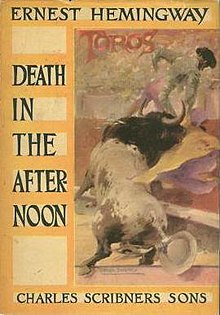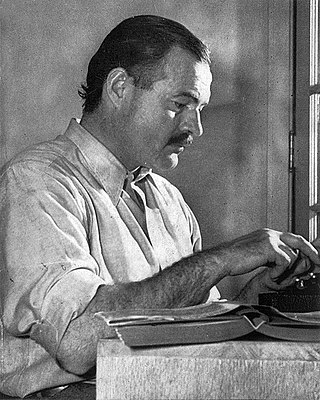
Ernest Miller Hemingway was an American novelist, short-story writer and journalist. Best known for an economical, understated style that significantly influenced later 20th-century writers, he is often romanticized for his adventurous lifestyle, and outspoken and blunt public image. Most of Hemingway's works were published between the mid-1920s and mid-1950s, including seven novels, six short-story collections and two non-fiction works. His writings have become classics of American literature; he was awarded the 1954 Nobel Prize in Literature, while three of his novels, four short-story collections and three nonfiction works were published posthumously.
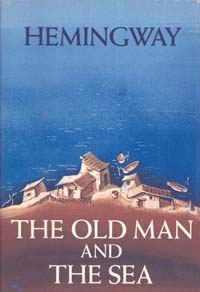
The Old Man and the Sea is a 1952 novella written by the American author Ernest Hemingway. Written between December 1950 and February 1951, it was the last major fictional work Hemingway published during his lifetime. It tells the story of Santiago, an aging fisherman, and his long struggle to catch a giant marlin. The novella was highly anticipated and was released to record sales; the initial critical reception was equally positive, but attitudes have varied significantly since then.

A Moveable Feast is a 1964 memoir by American author Ernest Hemingway about his years as a struggling expatriate journalist and writer in Paris during the 1920s. It was published posthumously. The book details Hemingway's first marriage to Hadley Richardson and his associations with other cultural figures of the Lost Generation in Interwar France.

The Sun Also Rises is the first novel by the American writer Ernest Hemingway. It portrays American and British expatriates who travel along the Camino de Santiago from Paris to the Festival of San Fermín in Pamplona and watch the running of the bulls and the bullfights. An early modernist novel, it received mixed reviews upon publication. Hemingway biographer Jeffrey Meyers writes that it is now "recognized as Hemingway's greatest work" and Hemingway scholar Linda Wagner-Martin calls it his most important novel. The novel was published in the United States in October 1926 by Scribner's. A year later, Jonathan Cape published the novel in London under the title Fiesta. It remains in print.

The Garden of Eden is the second posthumously released novel of Ernest Hemingway, published in 1986. Hemingway started the novel in 1946 and worked on the manuscript for the next 15 years, during which time he also wrote The Old Man and the Sea, The Dangerous Summer, A Moveable Feast, and Islands in the Stream.
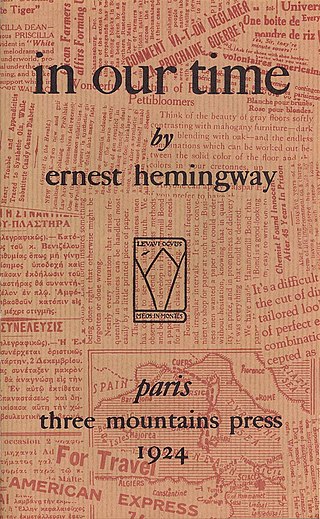
In Our Time is the title of Ernest Hemingway's first collection of short stories, published in 1925 by Boni & Liveright, New York, and of a collection of vignettes published in 1924 in France titled in our time. Its title is derived from the English Book of Common Prayer, "Give peace in our time, O Lord".

Across the River and Into the Trees is a novel by American writer Ernest Hemingway, published by Charles Scribner's Sons in 1950, after first being serialized in Cosmopolitan magazine earlier that year. The title is derived from the last words of U.S. Civil War Confederate General Thomas J. "Stonewall" Jackson: “Let us cross over the river and rest under the shade of the trees.”
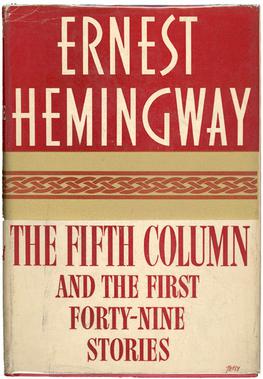
The Fifth Column and the First Forty-Nine Stories is an anthology of writings by Ernest Hemingway published by Scribner's on October 14, 1938. It contains Hemingway's only full-length play, The Fifth Column, and 49 short stories.

Men Without Women (1927) is the second collection of short stories written by American author Ernest Hemingway. The volume consists of 14 stories, 10 of which had been previously published in magazines. It was published in October 1927, with a first print-run of approximately 7,600 copies at $2.

Winner Take Nothing is a 1933 collection of short stories by Ernest Hemingway. Hemingway's third and final collection of stories, it was published four years after A Farewell to Arms (1929), and a year after his non-fiction book about bullfighting, Death in the Afternoon (1932).

Elizabeth Hadley Richardson was the first wife of American author Ernest Hemingway. The two married in 1921 after a courtship of less than a year, and moved to Paris within months of being married. In Paris, Hemingway pursued a writing career, and through him Richardson met other expatriate American and British writers.

The iceberg theory or theory of omission is a writing technique coined by American writer Ernest Hemingway. As a young journalist, Hemingway had to focus his newspaper reports on immediate events, with very little context or interpretation. When he became a writer of short stories, he retained this minimalistic style, focusing on surface elements without explicitly discussing underlying themes. Hemingway believed the deeper meaning of a story should not be evident on the surface, but should shine through implicitly.

"Big Two-Hearted River" is a two-part short story written by American author Ernest Hemingway, published in the 1925 Boni & Liveright edition of In Our Time, the first American volume of Hemingway's short stories. It features a single protagonist, Hemingway's recurrent autobiographical character Nick Adams, whose speaking voice is heard just three times. The story explores the destructive qualities of war which is countered by the healing and regenerative powers of nature. When it was published, critics praised Hemingway's sparse writing style and it became an important work in his canon.
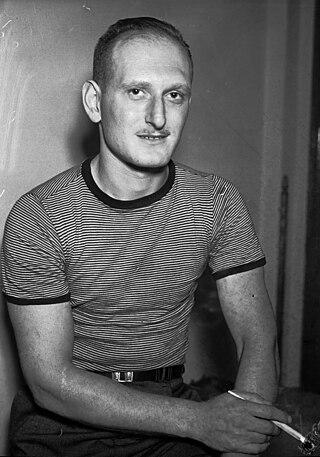
Sidney Franklin was the first American to become a successful matador, the most senior level of bullfighter.

"Cat in the Rain" is a short story by American author Ernest Hemingway (1899-1961), first published by Richard Hadley of Boni & Liveright in 1925 in the short story collection In Our Time. The story is about an American husband and wife on vacation in Italy. Critical attention focuses chiefly on its autobiographical elements and on Hemingway's "theory of omission".

Pauline Marie Pfeiffer was an American journalist and the second wife of writer Ernest Hemingway.

Dateline: Toronto is a collection of most of the stories that Ernest Hemingway wrote as a stringer and later staff writer and foreign correspondent for the Toronto Star between 1920 and 1924. The stories were written while he was in his early 20s before he became well-known, and show his development as a writer. The collection was edited by William White, a professor of English literature and journalism at Wayne State University, and a regular contributor to The Hemingway Review.
Querencia is a metaphysical concept in the Spanish language. The term comes from the Spanish verb "querer", which means "to desire". It has also been defined as "homing instinct, a favorite place" Larousse Gran Diccionario Español InglésEnglish Spanish (1994).

"Indian Camp" is a short story written by Ernest Hemingway. The story was first published in 1924 in Ford Madox Ford's literary magazine Transatlantic Review in Paris and republished by Boni & Liveright in Hemingway's first American volume of short stories In Our Time in 1925. Hemingway's semi-autobiographical character Nick Adams—a child in this story—makes his first appearance in "Indian Camp", told from his point of view.

Diego Mazquiarán, often called simply Fortuna, was a Spanish matador.
